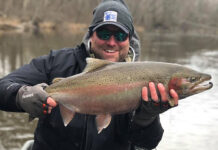As we came into this fall I was hopeful — hopeful that with the show of extra snow early in the fall and winter, we’d have a good freeze and stay out of the mud and muck.
Well, here in Southeast Ohio, that hasn’t been the case. We are currently in a bit of a cold snap, but warmer weather is on the horizon for next week and we no doubt are right back to the fight of soil loss, compaction and overall degradation of our most valuable resource, the land.
A couple of ways to improve the condition and make winter feeding more endurable is to consider a heavy use area and access roads.
Heavy use area
It is pretty common to hear about folks installing a heavy use area pad (HUAP) these days because it is such a practical solution for the problem of mud and manure while animals are in winter confinement.
Heavy use pads are generally constructed of gravel or concrete. Both are great options, but concrete tends to be easier to maintain. Concrete can be scraped multiple times over a series of years while screenings have to be replaced on gravel pads as they are scraped.
It is important when constructing a HUAP that a producer has geotextile fabric laid before install to keep gravel from skinning into mud in the subsurface of the soil.
Access road
An extension of the heavy use area is the access road. An access road is made very similarly to a heavy use pad, but is gravel, and a travel corridor for heavy equipment and hay. These highways help ensure that soil degradation isn’t occurring from the point of the hay storage to the areas it’s being fed.
Grazing systems
These are solutions to mud and muck while dealing with livestock in a confinement situation; a more permanent solution would be to consider moving towards a grazing system that allows for longer grazing into the winter. Some ways producers can consider this would be by strip grazing stockpiled forages or feeding winter annuals. All of these solutions take time and planning to make strides in improving the winter feeding woes.
I’d encourage you to reach out to folks that have experience in installing these kinds of practices, which might be staff from your county soil and water conservation district or NRCS personnel. Advice doesn’t cost anything more than your time.
Best of luck this winter, and I hope you don’t get stuck in the mud.













